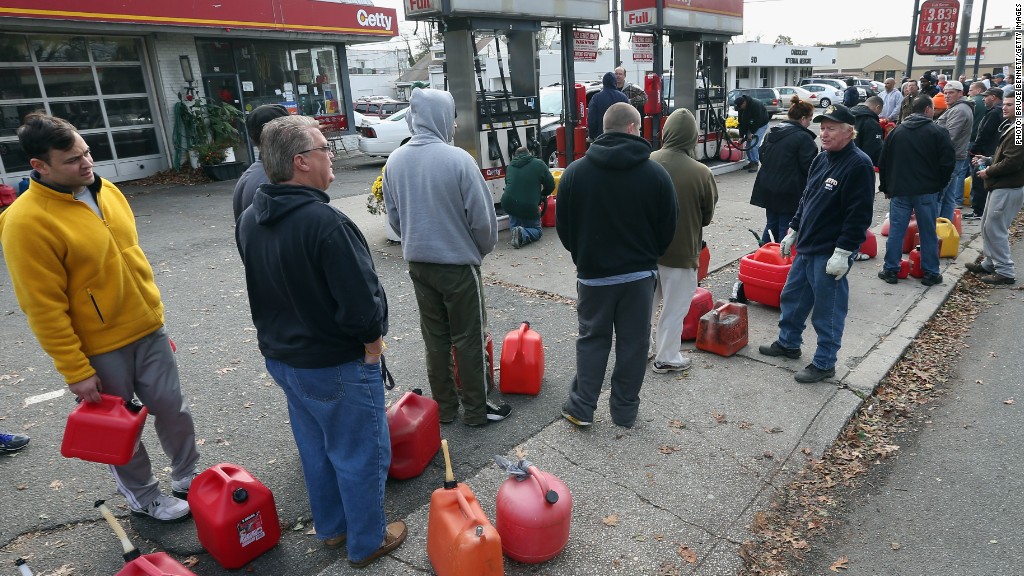
Superstorm Sandy has left a gasoline panic in its wake.
The storm had barely left the Northeast last week, when a frightening sight became common in New Jersey, New York and Connecticut -- dozens of shivering people standing in lines with jerry cans for gasoline to power up their darkened homes with generators, and cars stretching out miles deep, some waiting four hours to fill up.
Conjuring up images of the 1970s oil crisis, the lines spilled on to bridges and highways, as police officers secured some stations and directed traffic to keep peace. In New Jersey, stations in 12 counties are rationing gas, tying access to license plate numbers.
Amid this chaos, it's hard to believe that there's actually no gas shortage, as one well-known oil and gas expert explained to CNNMoney. Rather it's fear and panic that has gripped residents from these states.
Such behavior is actually common after large storms -- long gas lines plagued South Florida in the days after Hurricane Wilma, and were widespread in the Gulf Coast after Hurricanes Katrina and Rita, all storms that hit the nation in 2005.
CNNMoney caught up with Tom Kloza, chief analyst at the Oil Price Information Service, to explain the phenomena. Kloza says the panic has been fueled by social media, which has led to the equivalent of flash mobs at gas stations. He expects the panic to subside this coming week because millions of gallons of gasoline are waiting underground and will start flowing once power is restored.
Here are edited excerpts from the conversation.
Why are the gas lines so long?
Why do people rush the exits at a European soccer game? Why do people behave irrationally at times? Because of fear and panic. What might otherwise be just an annoyance turns into a momentary crisis, because everyone starts to top off their tanks when they believe there is an underlying gasoline shortage.
So, there's no energy crisis?
This is really a crisis of crowds. You can imagine, when everyone automatically assumes, "I better get gas today -- I'm going to top off my tank," you have behavior like the '70s. This is the not the '70s. Richard Nixon is not president. We're not wearing bell bottoms. We're not listening to eight tracks. Hopefully, we're not on acid trips. We're looking at something that's going to be resolved in a few days, despite all the madness of crowds.
What's different with this gas panic?
In this case, social media has created the equivalent at flash mobs at various stations. People are saying: "Oh, I hear the Hess station has gasoline." The word spreads. And boom -- the crowd goes there.
So, there's actually enough gas?
There's actually plenty of gasoline in the New York harbor area. And all the big storage tanks along the Jersey turnpike, plenty of those are filled with gas. The problem is, without electricity these facilities can't open, and it's very difficult to access the fuel. You see lines after a storm, because people perceive there's no gasoline, when in fact, it's a question of access.
The gas supply is there, it's either underground at stations that have yet to have electricity back on or in New York harbor, in terminals, but one needs electricity to access those terminals.
Related: Gas shortage continues in areas hit by Sandy
How much gasoline is out there?
Some of these bulk storage tanks have 250,000 barrels or 10 million gallons. Plus, the refineries in Texas and Louisiana continue to pump fuel up this way. The refineries on the Delaware River never lost power and continue to pump fuel. We lost about 300,000 barrels a day from refineries in the Linden, New Jersey area, but that's about 1/50th of the current U.S. supply.
Part of the reason it's going slowly is: You want to make sure everything is safe and secure and that you don't have the possibility for leaks.
When will these long lines end?
If we had normal demand, and we didn't have the panic out there, I'd suggest it would be in a few days. I still think that after the election this week, from Wednesday on, it'll gradually be restored to normal. It's moving from the South to the North. South Jersey is already getting better and some of the panic is easing.
Will we see a hike in gas prices?
In New Jersey and New York, the price is essentially staying the same right now.
U.S. refineries are making plenty of fuel and the price of crude is cheap. Prices will actually be lower a week from now. In the next week or two, prices will drop to about $2.99 a gallon gasoline in many parts of the country. This morning the price nationally was $3.47 a gallon.


